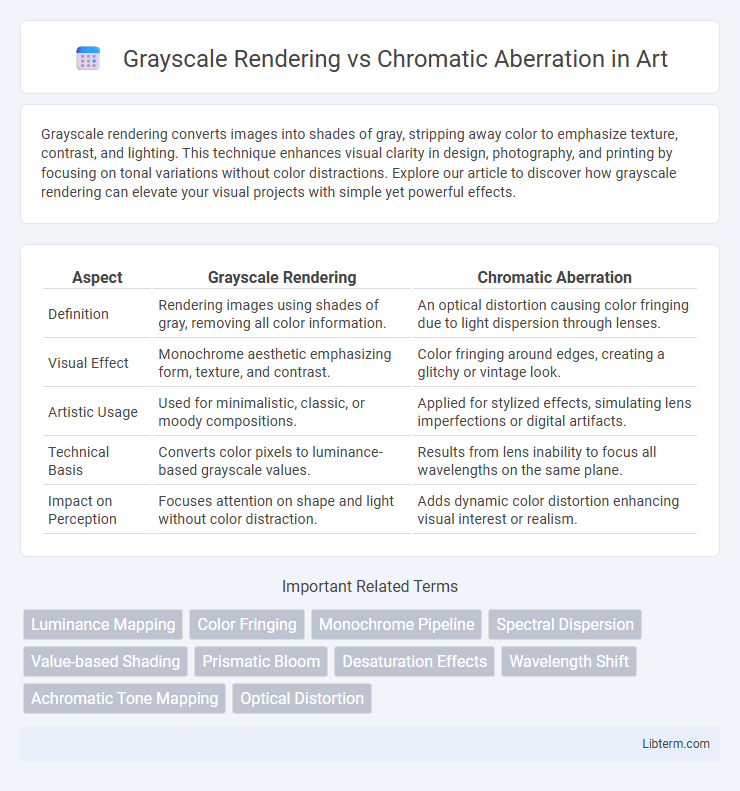Grayscale rendering converts images into shades of gray, stripping away color to emphasize texture, contrast, and lighting. This technique enhances visual clarity in design, photography, and printing by focusing on tonal variations without color distractions. Explore our article to discover how grayscale rendering can elevate your visual projects with simple yet powerful effects.
Table of Comparison
| Aspect | Grayscale Rendering | Chromatic Aberration |
|---|---|---|
| Definition | Rendering images using shades of gray, removing all color information. | An optical distortion causing color fringing due to light dispersion through lenses. |
| Visual Effect | Monochrome aesthetic emphasizing form, texture, and contrast. | Color fringing around edges, creating a glitchy or vintage look. |
| Artistic Usage | Used for minimalistic, classic, or moody compositions. | Applied for stylized effects, simulating lens imperfections or digital artifacts. |
| Technical Basis | Converts color pixels to luminance-based grayscale values. | Results from lens inability to focus all wavelengths on the same plane. |
| Impact on Perception | Focuses attention on shape and light without color distraction. | Adds dynamic color distortion enhancing visual interest or realism. |
Introduction to Grayscale Rendering
Grayscale rendering transforms images into shades of gray, removing color information while preserving luminance and contrast to emphasize texture and detail. This technique is widely used in computer graphics and photography for stylized effects and to enhance image analysis by reducing visual complexity. Unlike chromatic aberration, which introduces color fringing due to lens dispersion, grayscale rendering simplifies the visual data without color distortion.
Understanding Chromatic Aberration
Chromatic aberration occurs when a lens fails to focus all colors to the same convergence point, causing color fringes around high-contrast edges in images. This optical distortion results from varying refractive indices for different wavelengths of light passing through the lens, leading to misalignment of RGB channels in digital rendering. Understanding chromatic aberration is essential for optimizing visual fidelity in digital graphics, distinguishing it from grayscale rendering which removes color information entirely to emphasize luminance.
The Science Behind Each Technique
Grayscale rendering involves converting colors into varying shades of gray by measuring light intensity and luminance, which simplifies image details while preserving structure and contrast through precise light value calculations. Chromatic aberration results from lens dispersion where different light wavelengths refract at varying angles, causing color fringing and blurring as red, green, and blue channels misalign during image formation. Both techniques manipulate light properties--grayscale by eliminating chromatic data to emphasize brightness and contrast, and chromatic aberration by showcasing optical imperfections originating from wavelength-dependent refraction.
Visual Impact: Grayscale vs Chromatic Effects
Grayscale rendering emphasizes form and texture by stripping away color, enhancing contrast and tonal variations for a stark, dramatic visual impact. Chromatic aberration introduces color fringes and distortions around edges, creating a dynamic and vibrant effect that mimics optical imperfections. The visual contrast between grayscale's minimalist clarity and chromatic aberration's colorful disruption influences perception by either highlighting structural details or invoking a sense of depth and motion.
Technical Implementation and Workflow
Grayscale rendering converts images into shades of gray by calculating luminance values based on RGB input, often using weighted averages to maintain perceived brightness, which simplifies processing for tasks like edge detection and texture analysis. Chromatic aberration involves simulating optical distortion by shifting color channels horizontally or vertically according to specific lens parameters, typically requiring shader programming to offset RGB layers and create a realistic fringing effect along high-contrast edges. Integrating these effects in a workflow demands precise control over color channels and pixel manipulation in graphics pipelines, utilizing GPU shaders to efficiently balance performance and visual fidelity during real-time rendering or post-processing stages.
Performance Considerations
Grayscale rendering generally demands less GPU processing power as it involves reducing color channels to shades of gray, leading to faster rendering times and lower memory bandwidth usage. Chromatic aberration requires more complex shaders to simulate color fringing and distortion, increasing computational overhead and potentially impacting frame rates in real-time applications. Optimizing performance for chromatic aberration effects often involves balancing shader complexity and resolution to maintain visual quality without significantly degrading rendering speed.
Use Cases in Modern Media
Grayscale rendering is widely used in modern media for stylistic purposes, enhancing dramatic effect in films, photography, and graphic design by removing color distractions and emphasizing contrast and texture. Chromatic aberration often appears in video games and virtual reality to simulate lens distortion, creating a more immersive and realistic visual experience by mimicking optical imperfections found in camera lenses. Both techniques serve distinct roles: grayscale for artistic mood and chromatic aberration for photorealistic augmentation and visual depth.
Artistic Applications and Creative Choice
Grayscale rendering emphasizes contrast, texture, and form by removing color distractions, allowing artists to explore composition and mood through shades of gray. Chromatic aberration introduces intentional color fringing and distortion, creating dynamic visual effects that evoke a sense of surrealism or digital glitch art. Both techniques serve distinct artistic applications: grayscale enhances minimalist or classic aesthetics, while chromatic aberration contributes to experimental and futuristic creative choices.
Limitations and Challenges
Grayscale rendering simplifies images by removing color information, which limits its effectiveness in applications requiring precise color differentiation, such as medical imaging or digital art. Chromatic aberration, caused by lens dispersion, creates color fringing that degrades image quality, posing challenges for high-precision optical systems and demanding complex correction algorithms. Both techniques face challenges in maintaining image fidelity under varying lighting and material conditions, impacting their usability in advanced visual technologies.
Choosing the Right Technique for Your Project
Choosing between grayscale rendering and chromatic aberration depends on your project's visual goals and narrative tone. Grayscale rendering enhances clarity and focus by eliminating color distractions, ideal for minimalist or mood-driven designs. Chromatic aberration introduces color distortion effects that add a dynamic, edgy aesthetic, perfect for futuristic or glitch-inspired themes.
Grayscale Rendering Infographic

 libterm.com
libterm.com